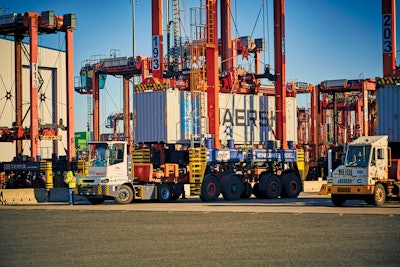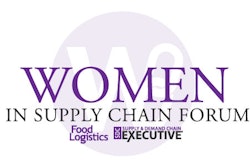
*This content is sponsored by Propane Education & Research Council (PERC)*
Ports require a bevy of vehicles for efficient material handling and most have a fleet that uses many different energy sources, making for complex calculations on operations cost and total cost of ownership. As more power sources become available, port leaders and their supply chain exec customers must focus on procurement, cost-management and environmental impact. These challenges affect small and large ports alike.
For large ports it’s an issue of cost – especially where the largest equipment is going electric, a big up-front investment – and for small ports one of cost and scale. That’s why more ports are turning to one gateway to sustainability: propane.
“One of the largest ports is Long Beach, where the West Basin Container Terminal has over 100 port tractors running on propane today,” explains Jim Bunsey, Director of Commercial Business Development at The Propane Education & Research Council (PERC). “And as far as the small ports, propane makes even more sense anytime the fleets are smaller. With propane, the infrastructure isn't just inexpensive, it's all but free. Whoever your propane provider is, they’re likely to put that infrastructure in for you at no cost, because when you sign a contract for your gallons that includes the cost of the infrastructure and storage.”
Reputation Management
Few industries have captured the attention of the public and policymakers like the port industry post-pandemic, says Ian Gansler, Manager of Energy Resilience and Sustainability Policy for the American Association of Port Authorities (AAPA). The photos of hundreds of vessels anchored off U.S. coasts made ports a convenient scapegoat for Americans who previously had not thought much about how they get their products. That’s led to an examination of port efficiency overall.
“Our ports are a central node in the supply chain,” Gansler says. “Our ports are moving and using large quantities of energy, and that makes our globalized economy possible. What happens at our ports affects every aspect of our world economy.”
Bunsey adds that it also led to an examination of how the ports impact the neighborhoods surrounding them. Ports tend to be in disenfranchised areas and are especially “susceptible to a lot of dirty diesel and bad emissions,” he says. Any way that can be eliminated – through a combination of direct port-to-rail access, port-located propane providers and electrification – helps the community.
Environmental Leadership
Propane-powered equipment offers near-zero emission options today and is well on the path to zero. And that makes the biggest difference to the ports’ communities.
“Equipment that uses propane can make really dramatic improvements in local air quality by reducing pollutant emissions compared to other traditionally fueled equipment,” Gansler says. “For any port that's looking to make an improvement in their emissions profile, propane is a great option.”
Near zero-emission renewable propane, made from things like vegetable oil, is already in production in the U.S. Industry projections suggest there will be 140 million gallons available in the U.S. by late 2024. That supply will especially be directed to large users like ports, says Bunsey.
“Propane is always scalable. Propane plays very well with hydrogen. Same thing with natural gas. There isn't one energy source that is going to fix our energy crisis,” he says, noting the variety of propane-hybrid options. “Ports are going to be a leader in micro-grids. Energy is going to be created where it's used.”
Lower Costs
With electric infrastructure strained by the large and mid-size equipment at many ports – gantry cranes, straddle carriers, reach stackers and empty container loaders, to name a few – propane is a common solution to moving away from diesel on small equipment like forklifts, terminal tractors and commercial generators.
It’s also much lower cost. A small port looking to get started with propane will invest about $50,000 to $80,000 in a simple system, Bunsey says. That’s likely about 1/10th the cost when compared to available alternatives like natural gas and electric. Bunsey says a 1,000-gallon propane tank, pump and regulators is then easily upgradeable as more of the port’s fleet turns green.
And “near zero” propane equipment priced comparably to diesel-powered is already available.
Made in the USA
Today there are two U.S. manufacturers of propane terminal tractors, says Bunsey, and several U.S. manufacturers of propane generators and forklifts.
“There’s equipment that is manufactured in the U.S. today that runs on propane and equipment that operates quite efficiently, in terms of duty cycles, refueling, and the ability to move large quantities of weight over long distances,” adds AAPA’s Gansler.
Because lightweight equipment has uses beyond ports, there’s also more long-term U.S. manufacturing interest. For other more specialized equipment, ports are looking to manufacturers and fuel sources available now and in the future since replacement can be harder. Again, propane is a top choice.
“With all these different types of equipment, it's really important from the ports' perspective to know where the energy is coming from,” Gansler says, “(and) to purchase equipment that has more reliable fuel distribution like propane or natural gas.”
Available Funding
Ninety percent of all internationally traded cargo moves over water, meaning nearly all goods travel through at least two ports. Because of that impact, ports have several opportunities for government funding to enact sustainability initiatives, including the Infrastructure Investment and Jobs Act and Inflation Reduction Act. Gansler points to two as especially critical: the Diesel Emissions Reduction Act, useful for retrofitting and replacing diesel engines with cleaner versions like propane, and the Port Infrastructure Development Program (PIDP), which is available for a broad array of applications.
The AAPA’s stance is that ports should be receiving a higher proportion of the available funding, and they’re working with the government to streamline processes to make that possible. Ports are generally state or local agencies with limited staff and limited budgets, and grant applications require just the opposite.
“This is particularly disadvantageous to small ports. To put together an application, you might spend $30,000 on a consultant, and they’re getting paid just waiting around for federal guidelines,” Gansler laments, pointing to an issue that happened with PIDP earlier this year. “Inefficiencies like that really disincentivize applicants.”
Next Generation of Business
Regardless of how ports weather the next few years of uncertainty from geopolitical upheaval with the Pacific Rim, the U.S. elections and ongoing supply chain disruption, port leaders will likely fan out into other industries with what they’ve learned. That means their knowledge of sustainable supply chains will propel other industries, even some that haven’t generally put clean energy at the forefront.
“A propane-powered terminal tractor isn’t just used in ports – they’re used in railroads, they're used in manufacturing facilities, they're used at distribution facilities. The average size of a fleet is three, and that means electric isn’t the best option. But port leaders know that propane is already here and a good option,” Bunsey says.
As go the ports, so go other industries in the next five years.
“This is an industry there for the taking,” Gansler says. “If the United States prioritizes the maritime industry and its infrastructure, the production of these fuels would have to happen at a port or near a port. We could be the world capital of methanol or hydrogen or ammonia or propane and create those fuels so that everyone knows they can get it at a U.S. port.”
















